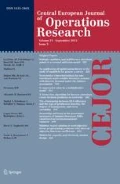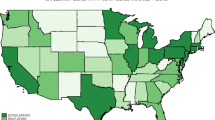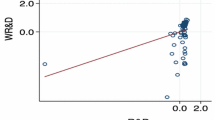Abstract
This paper explores the role of spatial spillovers in the innovation processes across 245 NUTS 2 European Union (EU) regions for the 2008–2012 period. The patent applications at the European Patent Office were chosen as a proxy for innovative activity. In the first step of the empirical analysis, the spatial pattern examination of the innovative activity based on the selected global and local indicators for spatial association confirmed the presence of a spatial dependence process in the distribution of innovative activity. Next, we attempted to model the behaviour of innovative activity at the EU regional level on the basis of extended regional knowledge production model. Spatial econometric analysis indicated the relevance of internal innovation inputs (R&D expenditure and human resources in science and technology) and we also found out that, the production of knowledge by EU regions seems to be also affected by spatial spillovers due to innovative activity performed in other regions.

Source: own calculations

Source: own calculations

Source: own calculations
Similar content being viewed by others
Notes
The year 2012 was the last published year of used statistics at the time of the analysis and the chosen time span was determined mainly by the availability of data.
The empirical part of the paper was carried out in the GeoDa, GeoDa Space and R software packages.
Natural Breaks Maps are constructed on the basis of the Jenks Natural Breaks algorithm (see e.g., De Smith et al. 2009).
The Box Map is an extended version of the Quartile Map, in which observations with extreme values in the first and fourth quartile are displayed separately.
With respect to the goal of the paper this analysis is not presented here.
Statistical inference was based on a random permutation procedure (for details see e.g., Getis 2010).
We do not report the results of other spatial versions of the model (8) due to insufficient space.
Testing the statistical significance of marginal impacts corresponding to different levels of neighbourhood was based on a simulation approach (see LeSage and Pace 2009).
References
Acs ZJ, Anselin L, Varga A (2002) Patents and innovation counts as measures of regional production of new knowledge. Res Policy 31:1069–1085
Anselin L (1988) Spatial econometrics: methods and models. Kluwer Publisher, Dordrecht
Anselin L (2003) Spatial externalities, spatial multipliers and spatial econometrics. Int Reg Sci Rev 26:153–166
Anselin L, Rey SJ (2014) Modern spatial econometrics in practice. GeoDa Press LLC, Chicago
Anselin L, Varga A (1997) Local geographic spillovers between university research and high technology innovations. J Urban Econ 42:422–448
Anselin L, Varga A, Acs Z (2000a) Geographical spillovers and university research: a spatial econometric perspective. Growth Change 31:501–515
Anselin L, Varga A, Acs Z (2000b) Geographic and sectoral characteristics of academic knowledge externalities. Pap Reg Sci 79:435–443
Audretsch DB, Feldman MP (1996) R&D spillovers and the geography of innovation and production. Am Econ Rev 86:630–640
Audretsch DB, Feldman MP (2004) Knowledge spillovers and the geography of innovation. Cities Geogr 4:2713–2739
Barro RJ (1990) Government spending in a simple model of endogenous growth. J Political Econ 98:103–125
Bogataj M, Drobne S (2005) Does the improvement of roads increase the daily commuting? Numerical analysis of Slovenian interregional flows. In: Zadnik SL, Indihar Štemberger M, Ferbar L, Drobne S (eds) Selected Decision Support Models for Production and Public Policy Problems. Slovenian Society Informatika, Ljubljana, pp 185–206
Charlot S, Crescenzi R, Musoleli A (2015) Econometric modelling of the regional knowledge production function in Europe. J Econ Geogr 15:1227–1259
Chocholatá M (2017) Analýza mzdových disparít v okresoch Slovenska v období 2001–2015. In: 17th International Scientific conference AIESA—Building of Society based on Knowledge
Coe D, Helpman E (1995) International R&D spillovers. Eur Econ Rev 39:859–887
Conte A et al (2009) An analysis of the efficiency of public spending and national policies in the area of R&D European Commission. http://ec.europa.eu/economy_finance/publications/publication15847_en.pdf. Accessed 5 Feb 2015
De Smith MJ, Goodchild MF, Longley PA (2009) Geospatial analysis a comprehensive guide to principles. Techniques and Software Tools Leicester, Matador
Drobne S, Bogataj M (2005) Intermunicipal gravity model of Slovenia. In: Zadnik Stirn L, Drobne S (eds) SOR ‘05 proceedings, proceedings of the 8th international symposium on operational research in Slovenia, Slovenian Society Informatika, Ljubljana, pp 207–212
European Commission (2010) Europe 2020: a European strategy for smart, sustainable and inclusive growth. http://eur-lex.europa.eu/LexUriServ/LexUriServ.do?uri=COM:2010:2020:FIN:EN:PDF. Accessed 5 Feb 2015
Feldman MP (1994) The geography of innovation. Kluwer Academic Publishers, Dordrecht
Feldman MP, Florida R (1994) The geographic sources of innovation: technological infrastructure and product innovation in the United States. Ann Assoc Am Geogr 84:210–229
Fujita M, Krugman PR, Venable AJ (1999) The spatial economy: cities, regions, and international trade. https://www.researchgatenet/publication/5182400_The_Spatial_Economy_Cities_Regions_and_International_Trade. Accessed 3 Feb 2017
Furková A (2016) Spatial pattern of innovative activity in the EU regions: exploratory spatial data analysis and spatial econometric approach. In: Gomes O (ed) Advances in applied business research: the LABS initiative. Nova Science Publishers, New York, pp 159–186
Getis A (2010) Spatial autocorrelation. In: Getis A (ed) Handbook of applied spatial analysis. Software tools, methods and applications. Springer, Berlin, pp 255–278
Gibbons S, Overman HG (2012) Mostly pointless spatial econometrics? J Reg Sci 52:172–191
Griliches Z (1979) Issues in assessing the contribution of research and development to productivity growth. Bell J Econ 10:92–116
Grossman GM, Helpman E (1991) Innovation and Growth in the Global Economy. The MIT Press, Cambridge, Massachusetts
http://ec.europa.eu/eurostat/. Accessed 5 Feb 2015
http://www.econ.uiuc.edu/~lab/workshop/Spatial_in_R.html. Accessed 6 Aug 2017
http://cranr-project.org and https://CRANR-project.org/view=Spatial. Accessed 6 Aug 2017
https://fhi.euba.sk/www_write/files/veda-vyskum/konferencie/aiesa/AIESA_2017/AIESA_2017__cely_zbornik.pdf. Accessed 2 Feb 2018
Ivaničová Z, Chocholatá M, Surmanová K (2012) Ekonometrické modelovanie. Ekonóm, Bratislava
Jaffe AB (1989) Real effects of academic research. Am Econ Rev 79:957–970
Jaffe AB, Trajtenberg M, Henderson R (1993) Geographic localization of knowledge spillovers as evidenced by patent citations. Q J Econ 63:577–598
Kelejian HH, Prucha IR (1998) A generalized spatial two stage least squares procedure for estimating a spatial autoregressive model with autoregressive disturbances. J Real Estate Finance Econ 17:99–121
Khan BZ (2012) Of time and space: a spatial analysis of technological spillovers among patents and unpatented innovations in the nineteenth century. http://www.nberorg/papers/w20732. Accessed 3 Feb 2017
Krugman P (1991) Increasing returns and economic geography. J Polit Econ 99(3):483–499
Kumar I (2008) Innovation clusters: a study of patents and citations ESRI international user conference. https://www.pcrd.purdue.edu/files/media/Innovation-Clusters-A-Study-of-Patents-and-Citations.pdf. Accessed 3 Feb 2017
LeSage J, Pace K (2009) Introduction to spatial econometrics. Chapman and Hall, Boca Raton
Lucas RE Jr (1988) On the mechanics of economic development. J Monetary Econ 22:3–42
Martin P, Ottaviano G (2001) Growth and agglomeration. Int Econ Rev 42:947–968
Moreno R, Paci R, Usai S (2005a) Spatial spillovers and innovation activity in European regions. Environ Plan A 37:1793–1812
Moreno R, Paci R, Usai S (2005b) Innovation clusters in the European regions. http://www.crenos.unica.it/crenos/sites/default/files/wp/05-12.pdf. Accessed 3 Feb 2017
Nijkamp P, Reggiani A (1992) Interaction, evolution, and chaos in space. Springer, Berlin
Ottaviano GIP, Puga D (1997) Agglomeration in the global economy: a survey of the “new economic geography”. http://diegopuga.org/papers/dp0356.pdf. Accessed 3 Feb 2017
Paas T (2000) The gravity approach for modelling international trade patterns for economies in transition. Int Adv Econ Res 6(4):633–648
Pakes A, Griliches Z (1980) Patents and R&D at the firm level: a first look. Econ Lett 4:377–381
Rebelo S (1991) Long-run policy analysis and long-run growth. J Polit Econ 99:500–521
Romer PM (1986) Increasing return and long-run growth. J Polit Econ 94:1002–1037
Romer PM (1990) Endogenous technological change. J Polit Econ 98:S71–S102
Solow RA (1956) A contribution to the theory of economic growth. Q J Econ 70(1):65–94
Venables A, Puga D (1999) Trading arrangements and industrial development policy. https://elibraryworldbank.org/doi/pdf/101596/1813-9450-1787. Accessed 3 Feb 2017
Author information
Authors and Affiliations
Corresponding author
Additional information
This work was supported by the Grant Agency of Slovak Republic—VEGA Grant No. 1/0248/17 “Analysis of regional disparities in the EU based on spatial econometric approaches”.
Rights and permissions
About this article
Cite this article
Furková, A. Spatial spillovers and European Union regional innovation activities. Cent Eur J Oper Res 27, 815–834 (2019). https://doi.org/10.1007/s10100-018-0581-4
Published:
Issue Date:
DOI: https://doi.org/10.1007/s10100-018-0581-4




